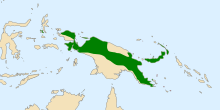| Papuan mountain pigeon | |
|---|---|

| |
| Scientific classification | |
| Domain: | Eukaryota |
| Kingdom: | Animalia |
| Phylum: | Chordata |
| Class: | Aves |
| Order: | Columbiformes |
| Family: | Columbidae |
| Genus: | Gymnophaps |
| Species: | G. albertisii
|
| Binomial name | |
| Gymnophaps albertisii Salvadori, 1874
| |

| |
| Synonyms | |
| |
The Papuan mountain pigeon (Gymnophaps albertisii) is a species of bird in the pigeon family, Columbidae. It is found in the Bacan Islands, New Guinea, the D'Entrecasteaux Islands, and the Bismarck Archipelago, where it inhabits primary forest, montane forest, and lowlands. It is a medium-sized species of pigeon, being 33–36 cm (13–14 in) long and weighing 259 g (9.1 oz) on average. Adult males have slate-grey upperparts, chestnut-maroon throats and bellies, whitish breasts, and a pale grey terminal tail band. The lores and orbital region are bright red. Females are similar, but have grayish breasts and grey edges to the throat feathers.
The Papuan mountain pigeon is frugivorous, feeding on figs and drupes. It breeds from October to March in the Schrader Range, but may breed throughout the year across its range. It builds nests out of sticks and twigs in a tree or makes a ground nest in short dry grass, and lays a single egg. The species is very social and is usually seen in flocks of 10–40 birds, although some groups can have as many as 80 individuals. It is listed as being of least concern by the International Union for Conservation of Nature (IUCN) on the IUCN Red List due to its large range and lack of significant population decline.
- ^ BirdLife International (2016). "Gymnophaps albertisii". IUCN Red List of Threatened Species. 2016: e.T22691850A93326139. doi:10.2305/IUCN.UK.2016-3.RLTS.T22691850A93326139.en. Retrieved 2021-11-11.
